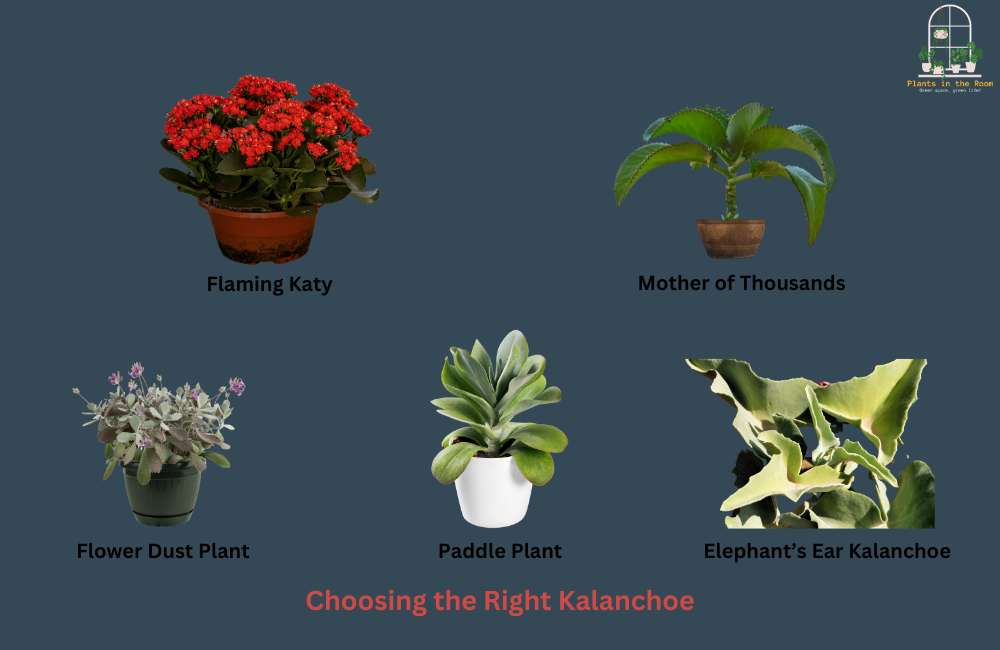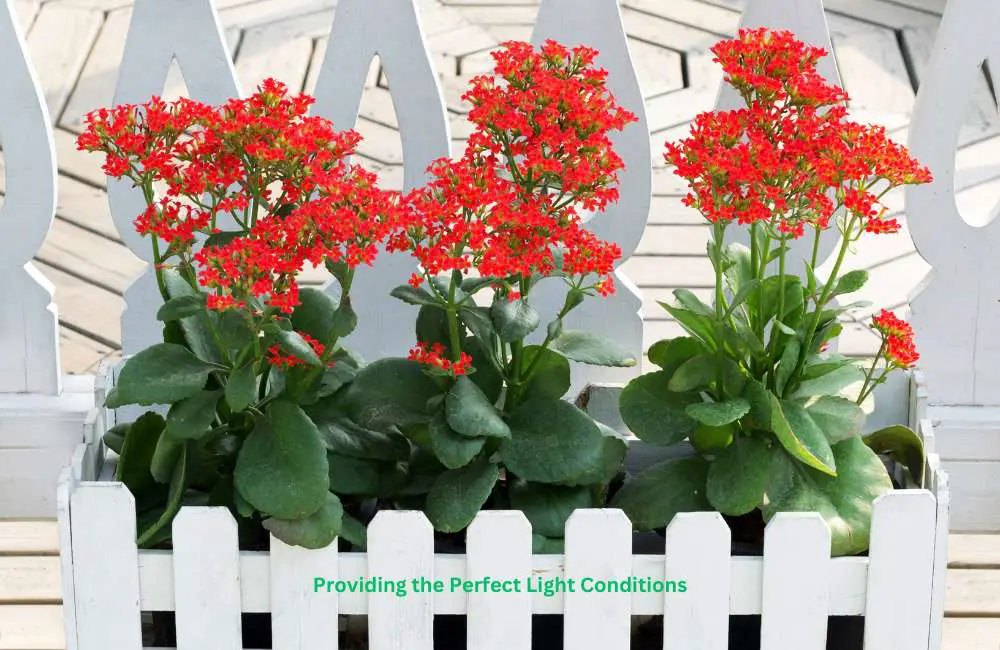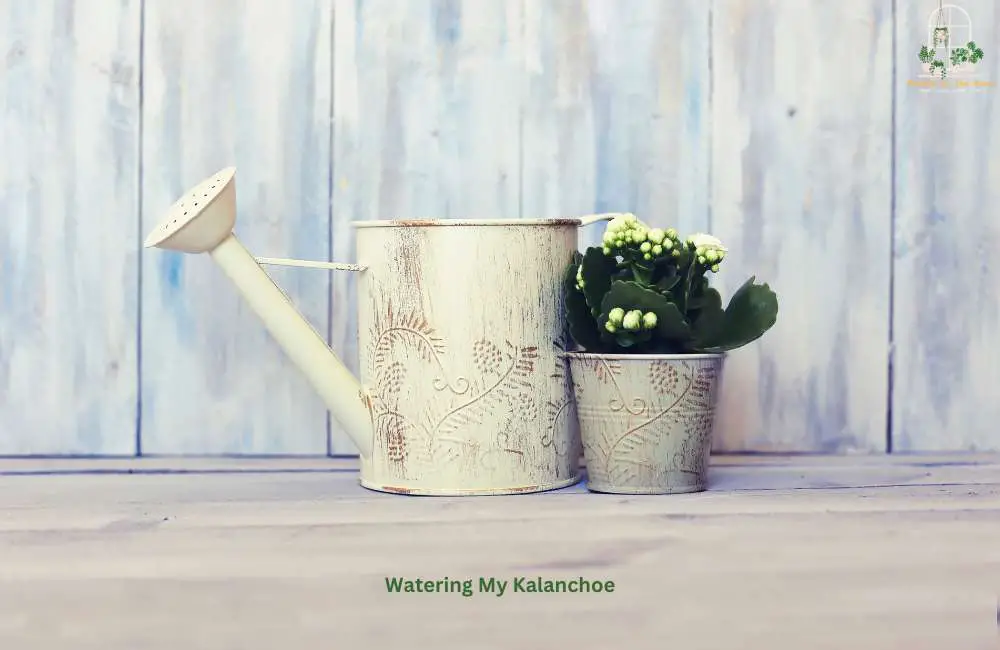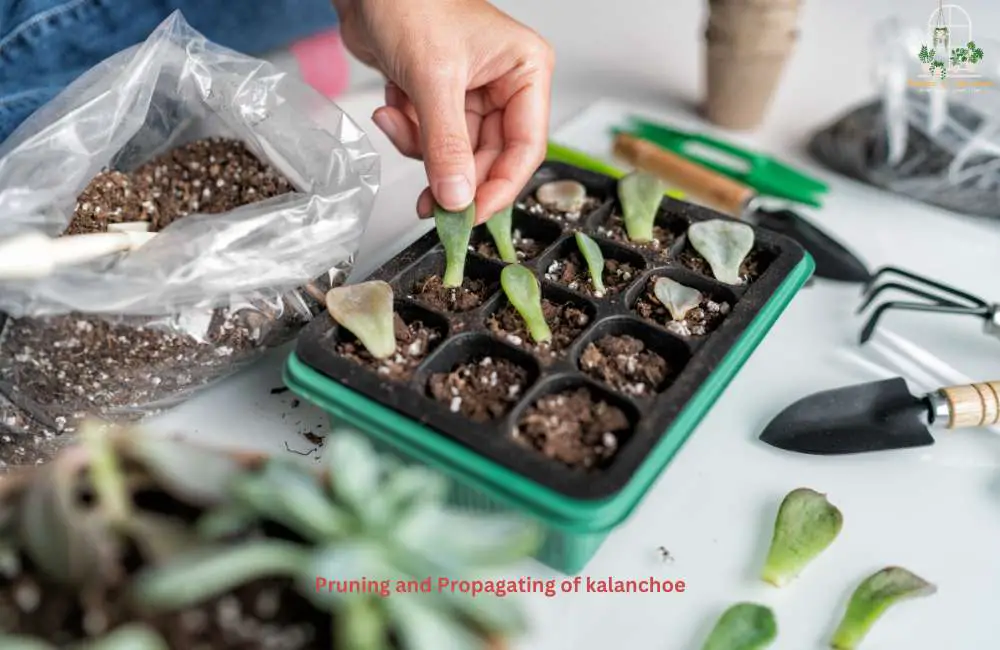This article covers the following areas –
- Choosing the Right Kalanchoe
- Providing the Perfect Light Conditions
- Watering My Kalanchoe
- The Ideal Temperature and Humidity
- Pruning and Propagating
- In Conclusion
As a plant lover, I’ve always been drawn to the allure of flowering houseplants, and the Kalanchoe has always held a special place in my heart. Their vibrant blooms and easy care requirements make them a wonderful addition to any indoor plant collection. Today, I’d like to share my personal guide on Kalanchoe care, from selecting the right plant to cultivating a stunning blooming spectacle.
Kalanchoe care involves providing ample sunlight, regular but moderate watering, maintaining warm temperatures, and occasional pruning. They thrive in bright, indirect light and prefer a ‘soak and dry’ watering method. Ideal temperatures range between 60°F (15°C) and 85°F (29°C).
Continue reading for more detailed instructions on providing optimal care for your Kalanchoe. We’ll dive into topics such as choosing the right type of Kalanchoe, perfecting the watering schedule, understanding the ideal light conditions, and mastering the art of pruning and propagation.

Choosing the Right Kalanchoe

Embarking on a Kalanchoe adventure is an exciting journey filled with vibrant colors and unique shapes. With over 100 varieties to choose from, each possessing a unique charm, the initial selection can seem a bit daunting. From the flamboyant flaming Katy with her bright clusters of flowers to the distinct leaf shapes of the mother of thousands, there’s a Kalanchoe for every plant lover.
#1 Flaming Katy (Kalanchoe blossfeldiana)
One of the most popular varieties, the Flaming Katy, is renowned for its vibrant and plentiful blooms. This compact, bushy plant usually grows between one and two feet tall, with dark green, glossy leaves. However, it truly sets this variety apart: its clusters of flowers that bloom in a spectrum of hues – red, orange, pink, yellow, or white. This long-blooming plant will add color to your space for weeks, typically between late autumn and early spring.
#2 Mother of Thousands (Kalanchoe daigremontiana)
The Mother of Thousands, also known as the devil’s backbone or alligator plant, is truly a unique and fascinating variety. This plant is named for the countless tiny plantlets forming on its leaves’ margins. When the plantlets mature, they drop off and quickly take root, making this Kalanchoe one of the easiest plants to propagate.
The leaves are long and narrow, with grey-green and purple-dotted edges. While it’s a fascinating plant to grow, remember to control its propagation, as it can become invasive if left unchecked.
#3 Flower Dust Plant (Kalanchoe pumila)
The Flower Dust Plant is an enchanting dwarf succulent subshrub. This variety forms a rounded mound with arching stems covered in small, serrated, blue-grey leaves dusted in a white powder that gives the plant its name. During late winter and early spring, the plant produces clusters of vibrant pink-violet flowers that can transform your space with a pop of color.
#4 Paddle Plant (Kalanchoe thyrsiflora)
The Paddle Plant is known for its striking, round, paddle-shaped leaves, which can provide an intriguing contrast to other plants in your indoor garden. The leaves are a stunning shade of light green and turn a striking red color on the margins when exposed to the right amount of sunlight. This plant also produces yellow flowers on a tall stalk, adding another layer of visual interest.
#5 Elephant’s Ear Kalanchoe (Kalanchoe beharensis)
The Elephant’s Ear Kalanchoe is a fascinating variety that’s more focused on foliage than flowers. It has large, triangular, velvet-like, silver-green leaves that can make a statement in any indoor garden. This variety can grow quite large, so it’s an excellent choice for floor locations with room to spread out.
Each of these Kalanchoe varieties has its own unique charm and can bring a distinctive touch of nature into your home. Whether you’re drawn to the vibrant blooms of the Flaming Katy or the fascinating leaf structures of the Mother of Thousands, there’s a Kalanchoe that’s just right for you.
Providing the Perfect Light Conditions

As I ventured into the realm of Kalanchoe care, I discovered their deep-rooted love for sunlight. Much like us humans, these plants rely on sunlight to thrive. The quantity and quality of light exposure significantly affect their growth, vibrancy, and flowering potential. In this section, I will share my insights and tips on providing your Kalanchoe with the optimal lighting conditions for a luscious and healthy plant life.
Getting the Right Amount of Sunlight
My Kalanchoe has shown me over time that it thrives best when placed in a spot where it can bask in bright, indirect light for a minimum of six hours daily. While they are sun-loving creatures, an important note is to avoid exposing them to direct sunlight. This can lead to scorched leaves, which isn’t a pretty sight and can harm their overall well-being.
The Importance of Monitoring Sunlight
Learning how to monitor and adjust the amount of sunlight my Kalanchoe receives was a critical part of my plant-care journey. I watchfully watch, particularly during the winter months when daylight hours dwindle. A lack of sufficient sunlight can cause your Kalanchoe to become ‘leggy’—a term we plant enthusiasts use when plants stretch and become spindly as they reach out for more sunlight.
Adjusting Light Exposure
To ensure your Kalanchoe gets the perfect amount of light, here are some tricks I’ve found useful over time:
Using the Right Window Exposure
Placement is key! Place your Kalanchoe near a north or east-facing window where it can enjoy the less intense but highly beneficial morning sun.
Sheer Protection
I recommend using a sheer curtain for south or west-facing windows, which receive the more intense afternoon sun. This will protect your plant from potential sun damage by diffusing the harsh rays while still providing plenty of light.
Considering Artificial Light
Consider supplementing with a grow light during winter or if your home lacks natural light. This will help meet your Kalanchoe’s light needs and keep it vibrant and healthy.
The Benefit of Regular Rotation
Make it a point to rotate your plant regularly to ensure all sides get equal exposure to the light source. This can prevent your Kalanchoe from leaning towards the light and helps to maintain an even, compact growth.
Understanding and adjusting to your Kalanchoe’s light needs is fundamental to its care. With the right light conditions, your plant will reward you with robust growth and a vibrant display of blooms. It’s worth every beam of sunlight!
Watering My Kalanchoe

Just like us, plants need water to survive. However, each plant species has unique watering needs, which is crucial for healthy growth. In my Kalanchoe care journey, I found that their watering needs differ greatly from many other houseplants. Kalanchoes, belonging to the succulent family, prefer a ‘soak and dry’ watering method.
Understanding the ‘Soak and Dry’ Watering Method
For those unfamiliar with the ‘soak and dry‘ approach, it’s exactly as it sounds. I water my Kalanchoe thoroughly, soaking the soil and then allowing the water to drain completely. It’s essential to ensure the plant doesn’t sit in standing water, as this can lead to root rot. This approach mimics the watering patterns of their natural desert habitats, where they experience periods of heavy rain followed by drought.
My Watering Schedule for Kalanchoe
Creating a watering schedule that suits your Kalanchoe’s needs can significantly impact its health and vitality. I typically check the soil once a week by gently pressing my finger into the top inch of the soil. If it feels dry, it’s time to water my plant again. This might sound too infrequent for some plant lovers, but remember, Kalanchoes are resilient and have adapted to survive in dry conditions. Overwatering can cause more harm than good.
During the winter months, the watering schedule changes slightly. As with most plants, Kalanchoes enter a period of dormancy in the colder months, meaning their growth slows down, and consequently, their water requirements decrease. In this period, I reduce my watering to once every two weeks.
Additional Watering Tips for Kalanchoes
Through trial and error, I’ve collected some additional tips that can help ensure your Kalanchoe stays hydrated without being waterlogged:
Use a Well-Draining Soil
Kalanchoes need a soil mixture that drains quickly. A succulent or cacti soil mix works well, but you can also create your own by mixing standard potting soil with perlite or coarse sand.
Water in the Morning
Watering in the morning allows the water to evaporate throughout the day, reducing the risk of waterlogging and diseases caused by dampness.
Water the Soil, Not the Leaves
When watering your Kalanchoe, aim for the soil, not the leaves. Wet leaves can lead to fungal growth, especially if not allowed to dry out.
Remember, when it comes to watering your Kalanchoe, less is often more. It’s better to under-water than over-water this resilient plant. With the right watering practices, your Kalanchoe will continue to delight you with its vibrant foliage and charming blooms.
The Ideal Temperature and Humidity
We all know that humans are comfortable in certain climate conditions, and it’s the same for plants, too! After mastering the watering requirements of my Kalanchoe, I turned my attention to understanding their preferred climate conditions, specifically temperature and humidity.
As desert natives, Kalanchoes appreciate a warmer environment and don’t require high humidity levels. Here’s a more detailed look at how I ensure my Kalanchoe has the right temperature and humidity to thrive.
Maintaining the Ideal Temperature for My Kalanchoe
Kalanchoes, with their desert origins, are lovers of warmth. They flourish in temperatures between 60°F (15°C) and 85°F (29°C). While they can tolerate slight dips in temperature, I’ve found that anything below 50°F (10°C) can harm my plant. Therefore, during winter, it’s crucial to keep my Kalanchoe indoors or in a heated greenhouse if you live in a region that experiences cold winters.
Also, remember to shield your plant from hot and cold drafts. A sudden temperature change can stress the plant, leading to leaf drop and other issues. I keep my Kalanchoe away from the path of air conditioning vents in summer and away from heaters in winter.
Navigating Humidity Levels for Kalanchoe
Unlike many tropical houseplants that crave high humidity, Kalanchoes are quite comfortable in a dry indoor environment. After all, they are native to arid desert regions with low humidity. So, you won’t need to invest in a humidifier or frequently mist your Kalanchoe to maintain humidity levels.
However, while they don’t require high humidity, they also don’t appreciate very dry air. In my experience, if the air in your home gets extremely dry, for instance, due to air conditioning or heating, it may be beneficial to occasionally mist the plant or place it on a tray filled with pebbles and a little water. The water in the tray will slowly evaporate, increasing the humidity around the plant.
Quick Tips to Create the Perfect Kalanchoe Climate
Over time, I’ve learned a few extra tips to ensure my Kalanchoe has the ideal climate to grow:
Avoid Extreme Temperature Fluctuations
Try to keep the environment consistent for your Kalanchoe. Sudden changes in temperature or humidity can stress the plant.
Watch Out for Signs of Stress
If your Kalanchoe’s leaves start to droop or change color, it might be a sign of stress due to incorrect temperature or humidity levels. Always observe your plant closely to catch any potential issues early.
In conclusion, creating the perfect climate for your Kalanchoe involves maintaining the right temperature and understanding their unique humidity needs. Doing so will enable your Kalanchoe to grow vibrantly and reward you with stunning blooms.
Pruning and Propagating

Plants are just like us – sometimes, they need a little trim to look their best, and they also have the ability to create new life. I discovered this firsthand with my Kalanchoe plants. Pruning and propagating are two vital processes that help my Kalanchoes thrive. Here’s a closer look at my personal methods and tips for these two key aspects of Kalanchoe care.
Pruning My Kalanchoe: Encouraging Fuller, More Vibrant Growth
Pruning my Kalanchoe helps maintain its shape and encourages fuller growth and more blooms. I’ve learned that it’s best to prune my Kalanchoe after the blooming season to help it retain its vibrant energy and prepare it for the next growth spurt. It’s like giving my plant a well-deserved break after it’s put on a fantastic floral display.
I prune the plant by cutting back the flower stems and any leggy growth to promote a more bushy appearance. I use clean, sharp scissors or pruners to make the cuts, and I always make sure to avoid injuring the main stem.
Propagating My Kalanchoe: Spreading the Joy with New Plants
For me, one of the joys of plant parenthood is the ability to propagate or create new plants. With Kalanchoes, propagation is easy and straightforward, and it’s always exciting to see a new plant emerge from a leaf or cutting.
Here’s how I propagate my Kalanchoes:
- Step One: Choose a Healthy Leaf or Stem – I start by selecting a healthy leaf or a piece of stem with a few leaves attached. The cutting doesn’t need to be large; a couple of inches long is enough.
- Step Two: Let the Cutting Dry – After taking the cutting, I let it dry out for a few days. This allows a callus to form over the cut end, which helps prevent rot when the cutting is planted.
- Step Three: Plant the Cutting – Once the cutting has dried and been cut, it’s time to plant it. I place it in a small pot filled with well-draining succulent or cactus mix, burying the callused end in the soil.
- Step Four: Wait for Growth – Patience is key here. I keep the soil slightly moist and wait for growth to appear, which usually happens within a few weeks.
So, that’s how I prune and propagate my Kalanchoes. Both processes are a crucial part of my plant care routine, and they add extra dimensions to the rewarding journey of caring for these vibrant, beautiful plants. With a little practice, you, too, can master these skills and keep your Kalanchoe plants looking their best.
In Conclusion
Caring for Kalanchoes can be a rewarding experience as these plants bring a pop of color and vitality to your living space. You can keep your Kalanchoe vibrant and healthy by understanding their basic needs and preferences, such as lighting, watering, temperature, and pruning.
Remember that Kalanchoes require patience and consistency in their care, like all plants. Once you’ve mastered these care techniques, you’ll be well-equipped to enjoy the beautiful blooms and lush growth these fascinating plants offer.






